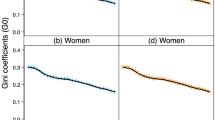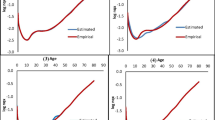Abstract
Despite the significant reduction in mortality over the past four decades, India contributes the biggest share of global premature deaths. This article reviews the trends in mortality differentials by age, sex, and region of residence in India during 1970–2010. For this purpose, trends in conventional mortality indicators such as life expectancy at birth (e 00 ), infant mortality rate ( 1 q 0 ), and adult mortality (45 q 15 ) obtained from the Sample Registration System are analyzed. Inequality indicators viz. ranges, dispersion measures of mortality, and population attributable fractions are calculated to quantify the mortality differentials across the states and districts of India. In general, life expectancy at birth in India substantially increased for both men and women in the past four decades, with significant variations observed from one decade to another. Compared to males, Indian females experienced faster reductions in mortality, with a converging pattern across Indian states. The gender gap in mortality has reversed and is more favorable to females. A north-south gradient in mortality is still observed. The rural–urban gap in infant mortality has reduced over time, with a clear stagnation in the urban infant mortality rate in recent years. The age pattern of mortality clearly varies from state to state. While a state such as Assam faces a higher burden of adult mortality, while states such as Madhya Pradesh and Orissa face a higher burden of infant mortality. Inequality analysis clearly showed that, in spite of a clear mortality convergence pattern over several decades, India still faces unacceptably high levels of mortality disparities at the state and district level.
Access this chapter
Tax calculation will be finalised at checkout
Purchases are for personal use only
Similar content being viewed by others
Notes
- 1.
In India, the eight socioeconomically backward states of Bihar, Chhattisgarh, Jharkhand, Madhya Pradesh, Orissa, Rajasthan, Uttaranchal, and Uttar Pradesh are referred to as the Empowered Action Group (EAG) states.
References
Balabanova, D., et al. (2013). Good health at low cost 25 years on: Lessons for the future of health systems strengthening. The Lancet, 381(9883), 2118–2133.
Bhat, P. N. M. (2002). Completeness of India’s Sample Registration System: An assessment using the general growth-balance method. Population Studies, 56(2), 119–134.
Bhat, P. N. M., & Rajan, I. S. (1990). Demographic transition in Kerala revisited. Economic and Political Weekly, 25(35/36), 1957–1980.
Bhat, P. N. M., Preston, S. H., & Dyson, T. (1984). Vital rates in India 1961–1981. Washington, DC: National Academy Press.
Caldwell, J. C. (1986). Routes to low mortality in poor countries. Population and Development Review, 12(2), 171–220.
Chaurasia, A. R. (2010). Mortality transition in India 1970–2005. Asian Population Studies, 6(1), 47–68.
Dyson, T. (2008). India’s demographic transition and its consequences for development. http://www.iegindia.org/timdysonlecture.pdf
Dyson, T., & Moore, M. (1983). On kinship structure, female autonomy, and demographic behavior in India. Population and Development Review, 9(1), 35–60.
Jain, A. (1985). Determinants of regional variations in infant mortality in rural India. Population Studies, 39(3), 407–424. doi:10.1080/0032472031000141596.
Kumar, B. G. (1993). Low mortality and high morbidity in Kerala reconsidered. Population and Development Review, 19(1), 103–121.
Mahapatra, P. (2010). An overview of the Sample Registration System in India. Paper presented at “Prince Mahidol Award Conference and Global Health Information Forum 2010”.
Mathers, C. D., Fat, D. M., Inoue, M., Rao, C., & Lopez, A. D. (2005). Counting the dead and what they die from: An assessment of the global status of cause of death data. Bulletin of World Health Organization, 83(3), 171–180.
Moser, K., Shkolnikov, V. M., & Leon, A. D. (2005). World mortality 1950–2000: Divergence replaces convergence from the 1980s. Bulletin of World Health Organization, 83(3), 202–209.
Nag, M. (1983). Impact of social and economic development on mortality: Comparative study of Kerala and West Bengal. Economic and Political Weekly, 18(19/21), 877–900.
Registrar General of India. (2011). SRS Bulletin, Sample Registration System, India, Vital Statistics Division. New Delhi: ISSN 0971-3549.
Roy, T. K., & Lahiri, S. (1988). Recent levels and trends in mortality in India and its major states: An analysis based on SRS data. In K. Srinivasan & S. Mukerji (Eds.), Dynamics of population and family welfare 1987 (pp. 279–349). Bombay: Himalaya Publishing House.
Saikia, N. (2011). Adult mortality in India: Levels, trends, determinants and causes. Unpublished PhD dissertation. Mumbai: International Institute for Population Sciences.
Saikia, N., & Ram, F. (2010). Determinants of adult mortality in India’. Asian Population Studies, 6(2), 153–171.
Saikia, N., Singh, A., & Ram, F. (2010). Has child mortality in India really increased in the last two decades? Economic & Political Weekly, 45(51), 63.
Saikia, N., Jasilionis, D., Ram, F., & Shkolnikov, V. M. (2011). Trends and geographic differentials in mortality under age 60 in India. Population Studies, 65(1), 73–89.
Saikia, N., Singh, A., Jasilionis, D., & Ram, F. (2013). Explaining the rural-urban gap in infant mortality in India. Demographic Research, 29(14), 473–506.
Sen, A. (1998). Mortality as an indicator of economic success and failure. The Economic Journal, 108(446), 1–25.
Shkolnikov, V. M., Andreev, E. M., & Begun, A. Z. (2003). Gini coefficient as a life table function: Computation from discrete data, decomposition of differences and empirical examples. Demographic Research, 8(11), 305–358.
Swamy, V. S., Saxena, A. K. J., Palmore, A., Mishra, V., Rele, J. R., Luther Norman, Y., & RGI. (1992). Evaluating the sample registration system using indirect estimates of fertility and mortality. New Delhi: Registrar General of India; 1992 Nov 24; Occasional Paper.
World Health Organization. (2012). Trends in maternal mortality: 1990–2010 WHO UNICEF UNFPA and the world bank estimates. https://www.unfpa.org/webdav/site/global/shared/documents/publications/2012/Trends_in_maternal_mortality_A4-1.pdf
Yadav, S., & Arokiasamy, P. (2014). Understanding epidemiological transition in India. Global Health Action, 7, 23248. http://dx.doi.org/10.3402/gha.v7.23248.
Acknowledgement
Author is grateful to Prof P M Kulkarni, JNU, New Delhi for his useful comments and suggestions. Author completed this study when she was a Max Planck India Fellow at Max Planck Institute for Demographic Research (MPIDR), Germany. Author is indebted to Dr Vladimir Shkolnikov and Dr Domantas Jasilionis at MPIDR for their advice on the methods used in this paper. Author is also grateful to Dr Nadia Diamond-Smith, University of California, San Francisco, for editorial assistance.
Author information
Authors and Affiliations
Corresponding author
Editor information
Editors and Affiliations
Rights and permissions
Copyright information
© 2016 Springer International Publishing Switzerland
About this chapter
Cite this chapter
Saikia, N. (2016). Trends in Mortality Differentials in India. In: Guilmoto, C., Jones, G. (eds) Contemporary Demographic Transformations in China, India and Indonesia. Demographic Transformation and Socio-Economic Development, vol 5. Springer, Cham. https://doi.org/10.1007/978-3-319-24783-0_3
Download citation
DOI: https://doi.org/10.1007/978-3-319-24783-0_3
Published:
Publisher Name: Springer, Cham
Print ISBN: 978-3-319-24781-6
Online ISBN: 978-3-319-24783-0
eBook Packages: Social SciencesSocial Sciences (R0)




